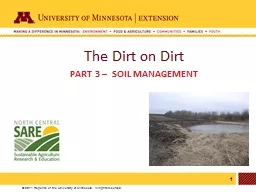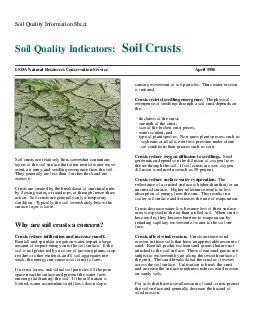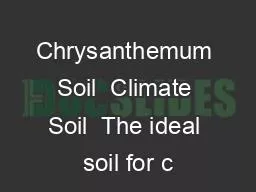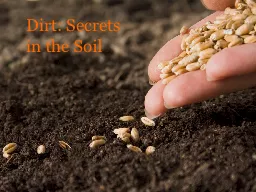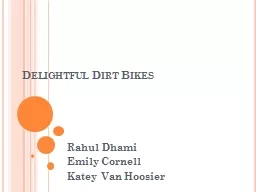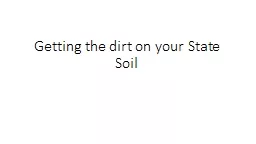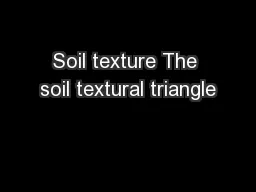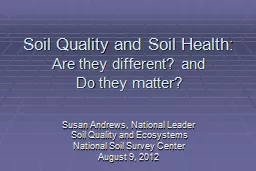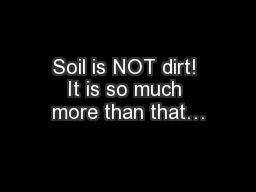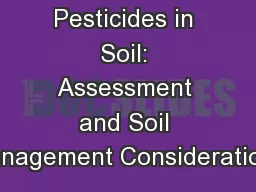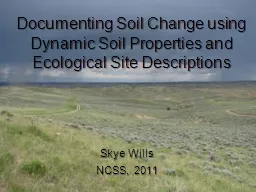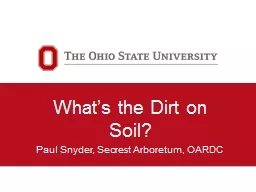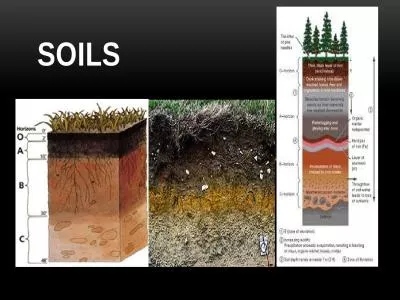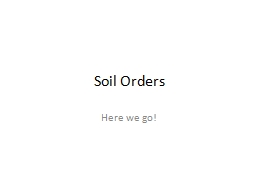PPT-The Dirt on Dirt Part 3 – Soil Management
Author : faustina-dinatale | Published Date : 2019-12-01
The Dirt on Dirt Part 3 Soil Management Review Parts 1 amp 2 focused on the elements of Soil Science In essence what you have In this section we will cover Fertility
Presentation Embed Code
Download Presentation
Download Presentation The PPT/PDF document "The Dirt on Dirt Part 3 – Soil Manage..." is the property of its rightful owner. Permission is granted to download and print the materials on this website for personal, non-commercial use only, and to display it on your personal computer provided you do not modify the materials and that you retain all copyright notices contained in the materials. By downloading content from our website, you accept the terms of this agreement.
The Dirt on Dirt Part 3 – Soil Management: Transcript
The Dirt on Dirt Part 3 Soil Management Review Parts 1 amp 2 focused on the elements of Soil Science In essence what you have In this section we will cover Fertility Drainage Erosion. The City may request additional information to verify that the soil complies with the CLEAN FILL DIRT requirements All loads are subject to inspection and testing upon arrival at the landf ill and must conform to the Clean Fill Dirt Program Terms a They generally are less than 2 inches thick and are massive Crusts are created by the breakdown of structural units by flowing water or raindrops or through freezethaw action Soil crusts are generally only a temporary condition Typically the soil im The soil should be neutral or slightly acidic with pH 65 to 70 having high organic content Very light sandy soils are not recommended owing to their poor moisture holding properties Climate Light Light is one of the most important climatic factors i How Much is Dirt Worth?. How Much is Dirt Worth?. Soils produce our food. They are essential to our survival.. How Much is Dirt Worth?. Soils produce our food. They are essential to our survival.. Good soils are a limited, nonrenewable resource.. Rahul Dhami. Emily Cornell. Katey Van Hoosier. Delightful Dirt Bikes. Dirt Bikes was created on the basis of wanting to deliver more to the consumers of dirt bikes.. We specifically cater to the female demographic between the ages of 12-25. We thought that their wants and needs were not taken into consideration by other companies selling dirt bikes. We wanted to be that company that can focus of all its marketing. . Step 1. State Soil Website. http://www.nrcs.usda.gov/wps/portal/nrcs/detail/soils/edu/?cid=stelprdb1236841. Example – Alabama State Soil – BAMA Series. Informational Paragraph. Landscape . Drainage, permeability. The delicacy of clay crystals. Soil crumb structure. Do not abuse clay!. Add plenty of organic matter. Avoid over-cultivation especially rotary cultivation. Use lime of gypsum to improve structure. Use green manure or mulch to cover the surface. Are they different? and . Do they matter?. Susan Andrews, National Leader. Soil Quality and Ecosystems. National Soil Survey Center. August 9. , . 2012. Soil Quality Definitions. “fitness for use”. Dirt. gets under our fingernails, and on our clothes…. …then what is . SOIL. ? . How does it differ from . dirt. ?. What is . SOIL. made up of?. MINERALS. . from rocks. AIR. . WATER. . ORGANIC MATTER . . 2015 SAM FALL FORUM . . SITE ASSESSMENT AND MITIGATION PROGRAM. . October 13, 2015. Skye Wills. NCSS, 2011. Soil and Ecosystem Change. Soil Change Guide. Document change in soil function applicable over the entire extent of a soil series or component phase. When possible, Ecological Sites and associated State and Transition Models inform study design and interpretation. Paul Snyder, . Secrest. Arboretum, OARDC. Why is soil important?. It supports life.. Living things need the proper temperature, oxygen, water, carbon and other nutrients. . What is soil?. How is soil made?. Soil Defined:. formed from the weathering of rocks and organic activity and is composed of loose rock fragments and clay derived from weathered rock mixed with organic material. . Soil is primarily made up of, broken down rock (minerals) and organic materials . Figure 3-24. Fig. 3-24a, p. 69. Mosaic of closely packed pebbles, boulders. Weak humus-mineral mixture. Dry, brown to reddish-brown with variable accumulations of clay, calcium and carbonate, and soluble salts.
Download Document
Here is the link to download the presentation.
"The Dirt on Dirt Part 3 – Soil Management"The content belongs to its owner. You may download and print it for personal use, without modification, and keep all copyright notices. By downloading, you agree to these terms.
Related Documents

